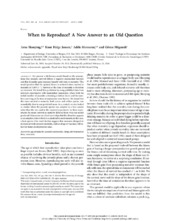| dc.contributor.author | Skorping, Arne | |
| dc.contributor.author | Jensen, Knut Helge | |
| dc.contributor.author | Mennerat, Adele | |
| dc.contributor.author | Högstedt, Göran | |
| dc.date.accessioned | 2016-12-30T07:50:07Z | |
| dc.date.available | 2016-12-30T07:50:07Z | |
| dc.date.issued | 2016-04 | |
| dc.Published | American Naturalist 2016, 187(4):540-546 | eng |
| dc.identifier.issn | 1537-5323 | en_US |
| dc.identifier.uri | https://hdl.handle.net/1956/15295 | |
| dc.description.abstract | We present a life-history model based on the assumptions that juvenile survival follows a negative exponential function and that fecundity gain increases linearly with time to maturity. This model predicts that the optimal fitness is achieved when survival at maturity is 0.368 (e−1). Survival at the time of maturity is therefore an invariant. We tested this prediction by using published data from infection experiments with mammalian nematodes, where both the initial number of juveniles colonizing a habitat (host) and the numbers surviving at the time of maturation were known. We found that the mean survival at maturity, both across and within species, was remarkably close to our predicted mean. As a control, we also looked at studies where the parasite species was adapted to a host species other than the one used in the reported experiment. In these experiments the mean survival at maturity differed from what our model predicted. Maturation at a fixed survival probability therefore appears as an adaptive trait evolved in a predictable environment, in this case, a host species. Our result further suggests that measures designed to increase juvenile parasite mortality, such as drugs or vaccines, will select for faster developmental rates. | en_US |
| dc.language.iso | eng | eng |
| dc.publisher | University of Chicago Press | en_US |
| dc.rights | Attribution CC BY-NC-SA | eng |
| dc.rights.uri | http://creativecommons.org/licenses/by-nc-sa/4.0 | eng |
| dc.subject | age at maturity | eng |
| dc.subject | parasitic nematodes | eng |
| dc.subject | drugs | eng |
| dc.subject | developmental time | eng |
| dc.subject | invariant | eng |
| dc.title | When to reproduce? A new answer to an old question | en_US |
| dc.type | Peer reviewed | |
| dc.type | Journal article | |
| dc.date.updated | 2016-12-13T09:45:26Z | |
| dc.description.version | publishedVersion | en_US |
| dc.rights.holder | Copyright 2016 by The University of Chicago | en_US |
| dc.identifier.doi | https://doi.org/10.1086/685423 | |
| dc.identifier.cristin | 1330774 | |

